May 24, 2025 | 16:24 GMT +7
May 24, 2025 | 16:24 GMT +7
Hotline: 0913.378.918
May 24, 2025 | 16:24 GMT +7
Hotline: 0913.378.918

Secretary of the Khanh Hoa Provincial Party Committee Nguyen Hai Ninh (far right) observing the launch ceremony for the high-tech open sea mariculture pilot program. Photo: Kim So.
During the launch ceremony for the high-tech open sea mariculture pilot program in Khanh Hoa province in 2023, Mr. Nguyen Hai Ninh, Secretary of the Provincial Party Committee, likened the event to a small step towards the ocean.
Consequently, the open sea mariculture pilot program has provided the mariculture industry in Khanh Hoa province with various new opportunities and solutions. The cobias and lobsters, released into the open sea by Khanh Hoa province's leadership in 2023, were harvested by the end of that year. The economic efficiency is evident, and the successful open sea mariculture model is paving the way for the development of Cam Ranh Bay.
Additionally, it will promote the development of various other mariculture regions such as Van Phong Bay, Nha Trang Bay, Nha Phu Lagoon, Van Ninh, among others located in the mariculture capital of the South Central Coast.
Cam Ranh Bay, often referred to as the mariculture capital of Khanh Hoa province, features a picturesque landscape. The Bay, with its significant potential and natural advantages for mariculture, quickly developed into the most renowned mariculture area in the South Central Coast region along with Van Phong Bay.
From the initial small-scale household mariculture, the Bay has developed to house over 100,000 mariculture cages, belonging to more than 2,000 households, and covering approximately 500 hectares of water surface area. The Bay's main mariculture species include scalloped spiny lobster, grouper, cobia, oyster, green mussel, and various types of clams. The spontaneous mariculture activities gradually developed into a movement, with a considerable number of farming cages located outside planned areas, and mariculture farmers unofficially increasing their number of cages. As a result, the local mariculture areas conflict with water areas designated for tourism and national security.

The pilot model enables coastal residents to engage in open sea mariculture in Cam Ranh Bay. Photo: Kim So.
Due to its excessively rapid rate of development, the mariculture industry in Cam Ranh Bay is often raised as a pressing issue regarding the repercussions of spontaneous aquaculture during national conferences and workshops. The significant number of mariculture cages, with rudimentary technology and a range of limitations, impose excessive strain on mariculture areas. As a result, the Bay is currently affected by environmental pollution, disease outbreaks among fish and shrimp, ecosystem distortion, and mariculture pressure.
According to several analyses conducted in mariculture areas within Cam Ranh Bay, Van Phong Bay, and Nha Trang Bay, a high concentration of bacteria were detected in local water samples. Notably, scientists warned that a number of these areas lack the requirements for sustainable aquaculture development. "After years of constant mariculture activities, with so much excess feed and waste dumped into the sea, the environment is bound to give out," stressed Mr. Nguyen Van Tho, a seasoned mariculture farmer in the bay.
Mr. Tho is one of the first three households in Cam Lap commune, Cam Ranh city, to participate in the high-tech open sea mariculture pilot program beyond the 3-nautical-mile zone in Cam Ranh Bay. Accordingly, the program is expected to yield tangible results in the mariculture revolution.
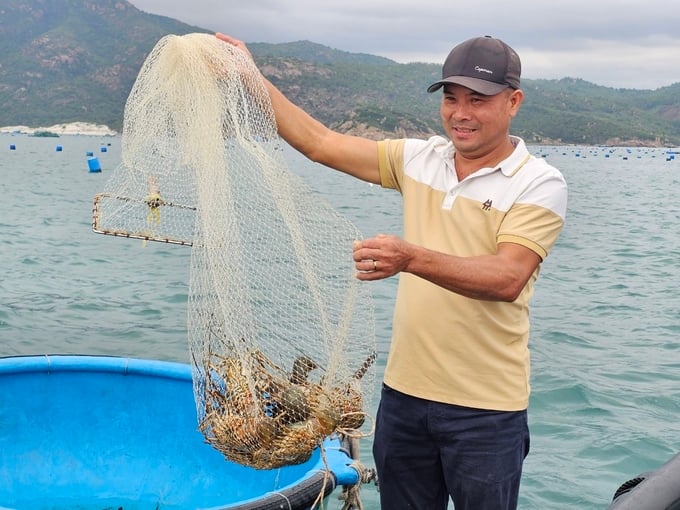
Mr. Nguyen Van Tho, one of the first three households in Khanh Hoa province to engage in open sea mariculture. Photo: Kim So.
Despite the challenges and uncertainties, Mr. Tho dedicated over ten years to nurturing open sea mariculture along the coast. He initially had doubts about his ability to bear the investment costs, and the quality of fish and shrimp compared to those farmed in the bay. According to him, open sea mariculture is a risky venture in which only major businesses are capable of making investments. However, with support from the government's program, Mr. Tho, along with Mr. Phan Van Thanh and Mr. Nguyen Van Cu, agreed to become the pioneers in "venturing into the open sea" in Khanh Hoa province.
With support from the Thien Tam Fund under Vingroup Corporation, the three households converted their traditional wooden farming cages into HDPE cages, and deployed them into the open sea beyond the waters of Cam Lap commune.
Provincial Party Secretary Nguyen Hai Ninh Nguyen Hai Ninh, in collaboration with local government leaders, released the first batch of fish and lobsters into the sea for the mariculture community on May 24, 2023. Two cages for fish and one for scalloped spiny lobster were deployed. Subsequently, the fish and lobsters are ready for harvest after eight months. "We raised lobsters on HDPE rafts, arranged into 12 compartments with two tiers. Each compartment houses 600 lobsters. After eight months, we harvested 1.3 tons of lobsters, and sold them at over 1 million dong per kilogram for a total profit of just over 300 million dong. Cobia farmers earned even more than I did," Mr. Tho recollected.
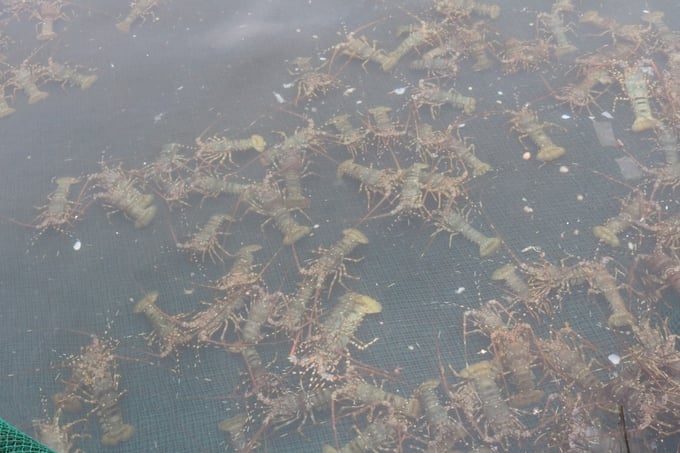
Open sea lobster farming. Photo: Hoang Anh.
Regarding fish mariculture, farmers released 2,000 seeds into two large, circular HDPE cages. Each of these cases has a diameter of 13 meters and a volume of 800 cubic meters. After over six months, each cage yielded approximately 12 tons of fish. During that period, they sold groupers at 170 thousand dong per kilogram, resulting in a profit of nearly 1 billion dong after deducting expenses.
Mr. Nguyen Van Cu's household experienced similar success in his mariculture endeavor. All three open sea mariculture pioneers in Cam Lap have quickly adapted to the new farming model. The new environment has proven conducive to the growth of fish and shrimp, dispelling their initial concerns. The farmers have also grown attached to life and mariculture activities on the open sea. In addition to financial gains, farmers have acknowledged other benefits of open sea mariculture.
"In the past, mariculture activities within the bay involve tightly packed cages; the polluted water killed all of the fish and shrimp, causing many families to go bankrupt. But the water is clean in open sea areas, with survival rates ranging from eighty to ninety percent, and there's not much to worry about. Most importantly, we find that open sea mariculture is relatively simple, which is contrary to what most people expect," shared the farmers who recently earned fortunes from their initial ventures.
Following the success of the first three models, Khanh Hoa province's Agricultural Extension Center has been tasked with implementing seven additional open sea mariculture models in the waters beyond Cam Ranh Bay. Mr. Huynh Kim Khanh, General Director of the Khanh Hoa province's Agricultural Extension Center, revealed: "By the end of this May, the Center will evaluate the results of the pilot models employed by 10 households in the open sea area of Cam Lap. So far, we can confirm that they have been successful."
"Compared to traditional cage farming, fish raised in large HDPE cages grow faster with lower mortality rates. The implementation of open sea mariculture models was affected by tropical storms and tropical depression; however, the impact has been minimal because the cages are made from HDPE materials. All of the models are equipped with satellite monitoring systems to track activities within the cages. In the event of an approaching storm, families can retreat to shore and their offshore assets or monitor the farming process through the camera system," Mr. Khanh stated.
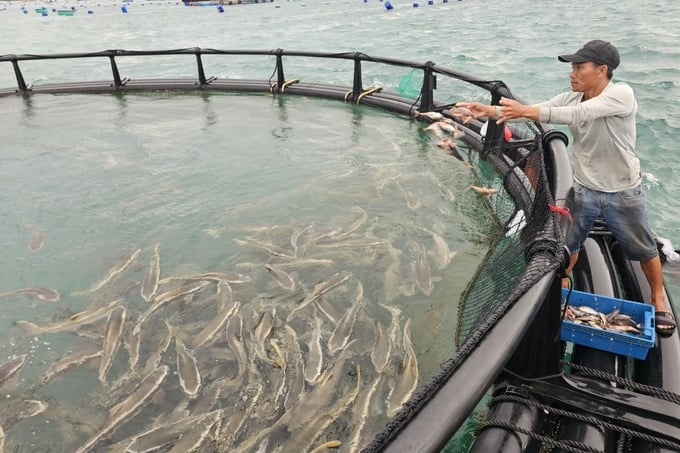
Open sea grouper farming, earning over 1 billion dong per year. Photo by Kien Trung.
According to Mr. Huynh Kim Khanh, these mariculture models have encouraged farmers to invest into the open sea. The primary challenge currently facing mariculture in Khanh Hoa province is the rapid growth of spontaneous mariculture activities along the coast, resulting in an excessive strain on the environment.
Encouraging farmers to venture beyond the 3-nautical-mile zone is a challenging task because local residents are accustomed to their habits and concerned about the high investment costs. However, these models have proven to be economically effective because HDPE cages are cheaper in comparison with wooden cages. Despite the higher initial investment cost compared to that of traditional practices, HDPE cages can last up to 20 years, which is significantly higher than the 5-year lifespan of wooden cages.
"According to Khanh Hoa province's strategy for mariculture development, offshore mariculture will be a mandatory trend to utilize local advantages, solve the problem of spontaneous, small-scale farming, and prevent conflicts with other sectors. The initial success in Cam Lap will serve as a scientific foundation for the mariculture industry in Khanh Hoa to expand beyond the coast," affirmed the Mr. Khanh.
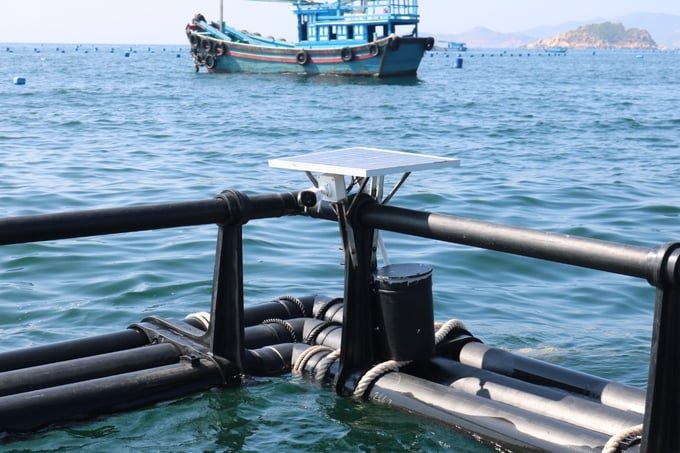
Solar energy system in open sea mariculture model. Photo: Kim So.
"Venturing into the vast ocean" is a phrase that Mr. Nguyen Duy Quang, Director of the Khanh Hoa province's Department of Agriculture and Rural Development, repeatedly emphasizes during our conversation regarding the province's strategy for mariculture development.
In addition to Quang Ninh and Kien Giang, Khanh Hoa has been designated by the government to become a mariculture center for its respective region. It is also the only province, to date, entrusted by the Prime Minister to develop a pilot project for high-tech mariculture. In addition to 4,000 hectares of traditional mariculture, the province will allocate 2,700 hectares of marine area for high-tech, industrial-scale mariculture.
The mariculture revolution in Khanh Hoa began with several innovative models, including the Australis Vietnam Aquaculture Company's Barramundi farming model in Van Phong Bay. Namely, the model utilized 70 HDPE circular cages, with an annual output ranging from 6,000 to 8,000 tons. Other examples include the permit farming model employed by the High-Tech Mariculture Center in Van Phong Bay with 42 HDPE cages, and an annual output ranging from 250 to 300 tons; the permit farming model employed by Phuong Minh Aquaculture Joint Stock Company with 11 HDPE cages, and an average annual output of 150 tons; among others.
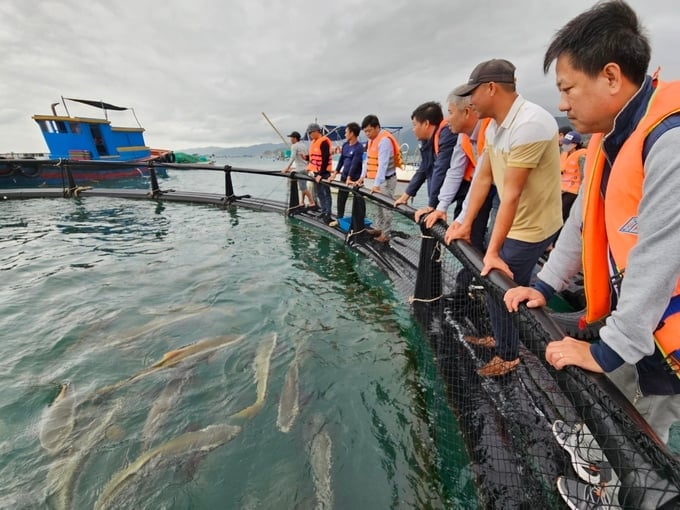
Open sea mariculture model opens up various solutions for mariculture in Khanh Hoa province. Photo: Kim So.
According to the Mr. Nguyen Duy Quang, in addition the goal of attracting investment from industrial-scale mariculture businesses, Khanh Hoa places special emphasis on supporting the transition of local residents towards offshore mariculture. "It will be impossible to sustain spontaneous and small-scale mariculture activities. If we want to encourage the people, we must prove to them that these models can be a success," Mr. Quang stressed.
At the time of writing, Khanh Hoa province reportedly houses 74,550 mariculture cages, with the primary mariculture species being saltwater fish and lobsters, and an estimated annual output of over 10,000 tons.
The development of mariculture in Cam Ranh Bay, Van Phong Bay, Nha Trang, and many other areas, also directly affects the livelihoods of over 4,000 coastal residents. "Accompanying the local residents in transitioning from small-scale and spontaneous mariculture towards industrial-scale operations is one of Khanh Hoa's primary objectives in mariculture development. Models like those in Cam Ranh Bay will be vital solution to this development," affirmed Mr. Nguyen Duy Quang.
Translated by Nguyen Hai Long

(VAN) The People's Committee of Tra Vinh province has approved an adjustment to the investment policy for the Green Hydrogen Plant project, increasing its area to approximately 52.76 hectares.
![Reducing emissions from rice fields: [2] Farmers’ commitment to the soil](https://t.ex-cdn.com/nongnghiepmoitruong.vn/608w/files/news/2025/05/05/dsc08881jpg-nongnghiep-140632.jpg)
(VAN) Clean rice cultivation model in Thuong Tan commune, Bac Tan Uyen district, is assisting local residents in achieving sustainable agriculture by substantially reducing costs, increasing productivity, and protecting the environment.

(VAN) At the conference to disseminate Resolution No. 68, AgriS introduced its digital agricultural ecosystem and reaffirmed its commitment to accompanying the Government in promoting private sector development and sustainable agriculture.

(VAN) 'Blue Ocean - Blue Foods' initiative is designed to restore marine ecosystems and establish sustainable livelihoods for local communities by cultivating a minimum of 1,000 hectares of cottonii seaweed in the first three years.
/2025/05/21/4642-3-112707_603.jpg)
(VAN) The V-SCOPE project has made direct contributions to three out of six pillars of the Comprehensive Strategic Partnership between Vietnam and Australia.

(VAN) Facing the threat of rabies spreading to the community, Gia Lai province urgently carries out measures to vaccinate dogs and cats on a large scale.

(VAN) Disease-free livestock farming not only protects livestock herds but also stabilizes production and livelihoods for many farmers in Tuyen Quang.